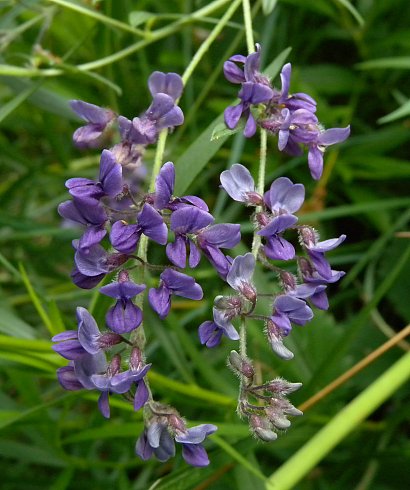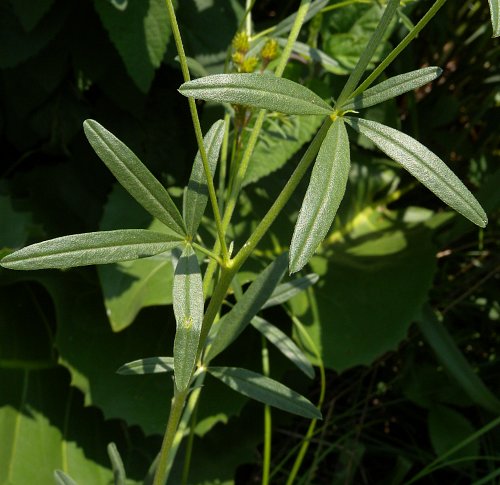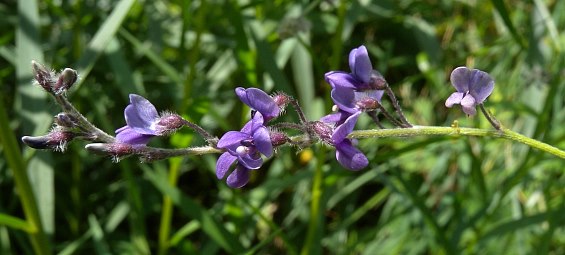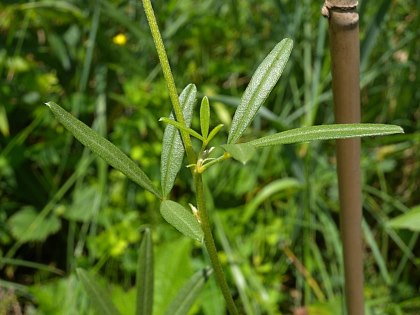Description: This herbaceous perennial wildflower is about 2-3' tall and abundantly branched above. The slender stems are light gray-green, terete, and glabrous to canescent. Alternate compound leaves occur at intervals along these stems: they are either trifoliate (3 leaflets) or palmate (4-5 leaflets), spanning up to 3" long and across. Individual leaflets are up to 1½" long and 1/3" (8 mm.) across; they are gray-green to green, narrowly elliptic-oblong to oblong, and smooth along their margins. The slender petioles are up to 1" long and they are usually shorter than the longer leaflets. At the base of each petiole, there is a pair of tiny linear stipules; these wither away with age.

Occasionally, narrow racemes of blue-violet flowers are produced from the upper stems on long peduncles (up to 4" long). These racemes are 1½–3" long and loosely flowered; 1-4 flowers develop at intervals along each raceme. Individual pea-like flowers are up to ¼" long (6 mm.), consisting of 5 blue-violet petals and a short calyx with 5 teeth. The calyx of each flower is light green green to purple and more or less hairy. Each flower has a short slender petiole; at the base of each petiole, there is a tiny scale-like bract. The blooming period occurs from late spring to late summer and lasts about 1-2 months. There is no noticeable floral scent. Each flower is replaced by a small seedpod about ¼" long that is ovoid and somewhat flattened, terminating abruptly into a short beak. Each seedpod contains only a single seed. The root system consists of a long slender taproot that runs deep into the ground. This wildflower reproduces by reseeding itself.

Cultivation:
The preference is full sun, dry conditions, and soil that contains
gravelly material, a little sand, or clay-loam. New plants can be
started from seeds, but growth and development are slow. Established
plants don't produce foliage until rather late in the spring, but they
develop quickly thereafter from the nutrients inside their taproots.
Resistance to drought is excellent.
Range & Habitat:
The native Scurfy Pea is uncommon in Illinois, occurring from the NE
section of
the state to the west-central section in counties that are located near
the Illinois river (see Distribution
Map). Illinois lies along the
eastern edge of its
distribution. Habitats include hill prairies, dry upland prairies and
gravel prairies, limestone glades, barren upland savannas, and areas
along railroads. Scurfy Pea is usually found in high quality habitats,
although it benefits from disturbance that reduces woody vegetation. In
particular, it responds well to occasional wildfires.

Faunal
Associations:
The flowers are pollinated primarily by small to medium-sized bees,
including the digger bee Svastra obliqua, the
cellophane bee Colletes willistoni, and the dagger
bee Calliopsis andreniformis. These bees are
attracted to the nectar of the flowers. Some grasshoppers eat the
foliage, including Melanoplus femurrubrum
(Red-legged Grasshopper), Melanoplus foedus
(Striped Sand Grasshopper), and Melanoplus packardii
(Packard's Grasshopper). The caterpillars of the flower moth Schinia
jaguarina feed on the developing seedpods, while the leaf
beetle Luperosoma parallelum feeds on the foliage.
The foliage of Scurfy Pea is occasionally browsed by White-Tailed Deer
and Cottontail Rabbits, even though it has been reported to be mildly
toxic to livestock. It is possible that some upland gamebirds and
granivorous songbirds eat the seeds, but records about this are lacking.
Photographic Location:
The wildflower garden of the webmaster in Urbana, Illinois.

Comments: This wildflower is more typical of prairies in regions that lie to the west of the Mississippi River. It has a rather loose bushy appearance with small blue-violet flowers. Two varieties of Scurfy Pea have been identified: the typical variety produces 1-2 flowers about 4-5 mm. long at intervals along each raceme, while var. floribunda produces 2-4 flowers about 6-7 mm. long at intervals along each raceme. Some specimens of Scurfy Pea may be intermediate in these characteristics and therefore difficult to classify according to variety. Scurfy Pea differs from similar species in the Bean family by having palmately compound leaves with 3-5 leaflets, a taller branching habit, petioles that are usually shorter than the leaflets, and rather loose racemes of small flowers. Another common name of this species is Wild Alfalfa; an older scientific name of this species is Psoralea tenuiflora.